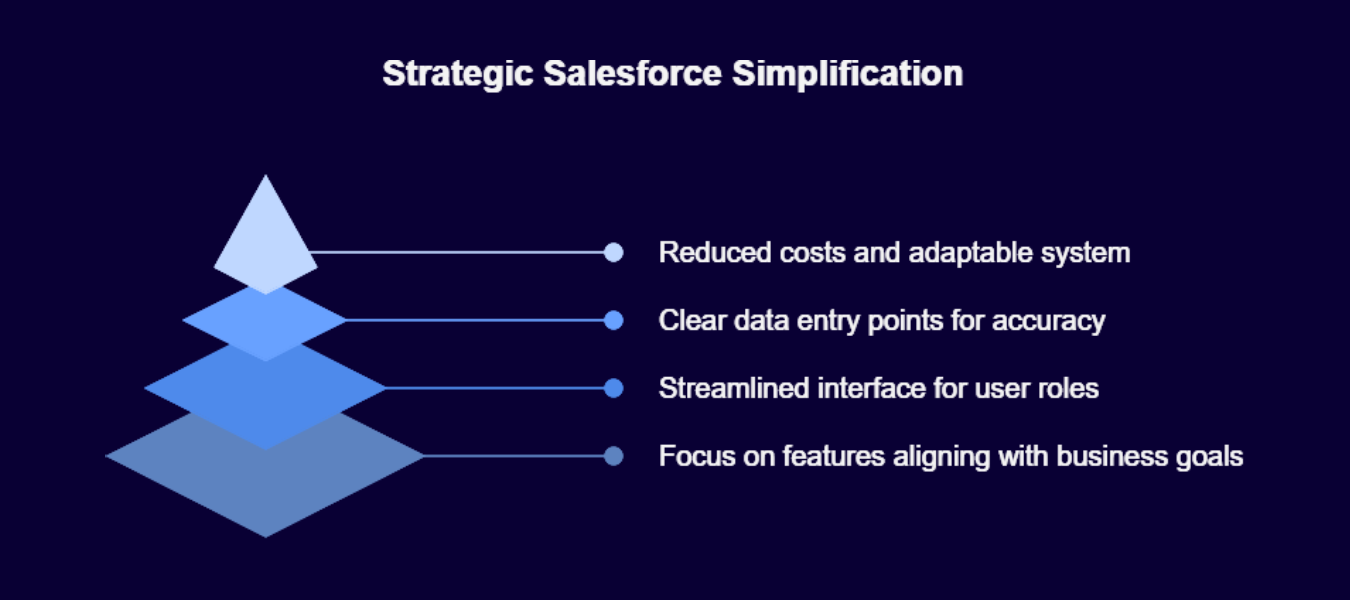
In the fast-paced world of enterprise technology, the allure of “more” can be intoxicating. New features, expanded functionalities, and an ever-growing suite of tools – it’s a common narrative, particularly within robust platforms like Salesforce. The perception is often that adopting every new offering equates to staying ahead, to maximizing investment. However, at Xccelerance Technologies, we advocate for a more discerning approach, challenging the notion that “feature bloat” is an inevitable path to success. In reality, a strategic, simplified approach to Salesforce can unlock far greater value and drive more impactful business outcomes.
The term “feature bloat” itself can be misleading. It suggests a platform becoming unwieldy and inefficient due to an overabundance of options. While Salesforce is undeniably a comprehensive platform with a vast array of capabilities, the “bloat” often stems not from the features themselves, but from an undiscriminating adoption strategy. The pressure to implement every new module or customize every possible pathway can lead to a system that is complex, difficult to navigate, and ultimately, underutilized.
Consider the user experience. When confronted with a bewildering number of fields, buttons, and processes that aren’t directly relevant to their roles, user adoption can plummet. Instead of empowering teams, an overly complex Salesforce instance can become a source of frustration, leading to inconsistent data entry, reliance on workarounds (ironically, often manual ones), and a general disengagement from the very tool designed to enhance productivity. Studies and anecdotal evidence suggest that many organizations only utilize a fraction of their CRM’s capabilities, sometimes as low as 50%. This isn’t just a missed opportunity; it’s an indicator of diluted ROI.
The pursuit of “more” can also obscure the core objectives of a CRM: to streamline sales processes, enhance customer relationships, and provide actionable insights. When the focus shifts to simply implementing features for features’ sake, these fundamental goals can get lost in the noise. The result? A system that might do a lot, but doesn’t necessarily do what your business needs most, effectively.
The Power of Strategic Simplification
The antidote to this perceived “feature bloat” isn’t to shy away from Salesforce’s power, but to harness it with precision. Strategic simplification is about making deliberate choices, focusing on the features and customizations that directly align with your specific business processes and strategic objectives.
Here’s how a simplified, strategic approach can lead to greater success:
-
Enhanced User Adoption and Productivity:
A streamlined interface, tailored to specific user roles and daily tasks, is intuitive and easier to learn. This directly translates to higher adoption rates, more consistent data entry, and ultimately, a more productive workforce. When users can quickly find what they need and complete tasks efficiently, the CRM becomes an enabler, not a hurdle.
-
Improved Data Quality and Insights:
Complexity can breed errors and inconsistencies in data. A simplified system, with clear data entry points and relevant fields, promotes higher quality data. This, in turn, fuels more accurate reporting and more reliable business intelligence, allowing for data-driven decision-making that truly impacts the bottom line. Salesforce’s own Adoption Dashboards can offer visibility into how key features are being used, helping to identify areas for simplification or further training.
-
Increased ROI and Reduced Costs:
By focusing on essential functionalities, organizations can often reduce implementation times and lower the costs associated with extensive customization, complex integrations, and ongoing maintenance. A leaner, more focused Salesforce instance means resources are allocated to what truly drives value, maximizing the return on your CRM investment. Phased implementations, for example, have been shown to reduce initial costs by as much as 40%.
-
Greater Agility and Scalability:
A less convoluted system is inherently more adaptable. As your business evolves, a simplified Salesforce org can be modified and scaled more efficiently than one burdened by layers of underutilized or overly complex features. This agility is crucial in today’s dynamic market.
Moving Beyond the “More is More” Mentality
Challenging the “feature bloat” fallacy requires a shift in mindset. It means moving away from the assumption that adopting every new Salesforce release or module is a de facto sign of progress. Instead, it’s about fostering a culture of strategic adoption.
Before implementing any new feature or customization, ask critical questions:
- How does this directly support a core business process?
- Will this demonstrably improve efficiency or user experience for a specific team?
- What is the tangible business outcome we expect to achieve?
- Can we achieve a similar outcome by optimizing existing functionalities?
At Xccelerance Technologies, we’ve seen firsthand the transformative power of a well-defined, strategically simplified Salesforce implementation. Companies that resist the urge to overcomplicate and instead focus on leveraging the right features for their specific needs are the ones that truly unlock the platform’s potential. They experience higher user engagement, cleaner data, more impactful insights, and ultimately, a greater return on their investment.
Salesforce is an undeniably powerful platform. The key to harnessing that power lies not in the sheer volume of features adopted, but in the wisdom of a simplified, strategic approach. It’s about making “less” work significantly “more” for your organization’s success.


